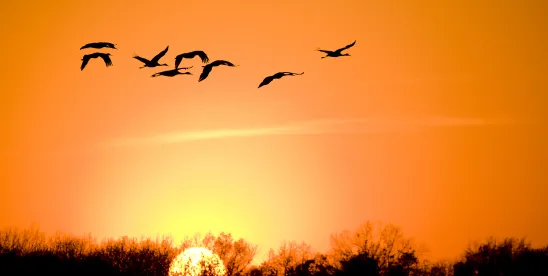Two recent developments signal important changes to the current administration’s position on incidental take under the Migratory Bird Treaty Act (“MBTA”):
- On April 11, the U.S. Department of Interior announced its revival of the legal position that incidental take is not prohibited under the MBTA.
- On April 21, the U.S. Fish and Wildlife Service withdrew an advance notice of proposed rulemaking signaling a stop to its efforts to develop a permitting program for the incidental take of migratory birds under the MBTA.
Both actions are linked to President Trump’s directive in Executive Order 14154, Unleashing American Energy, for agencies to suspend, revise, or rescind any agency actions identified as unduly burdensome to domestic energy resources.
In the short-term, the practical effects are very likely to include renewed litigation over DOI’s legal position and at least a pause in prosecution for incidental take under the MBTA for most of the United States. Long term effects may depend on how any litigation plays out, which may ultimately reach the U.S. Supreme Court. In the meantime, projects that grapple with MBTA impacts like transmission lines, wind generation, and oil and gas wastewater disposal pits may hedge their bets depending on project timelines.
Changes in Legal Interpretations
Enacted in 1918, the MBTA has made it unlawful to, among other things, pursue, hunt, capture, kill, or “take” a protected migratory bird species for over a century. However, the Act has never defined what it means by “take,” and agency regulations implementing the Act, like those of the U.S. Fish and Wildlife Service, merely echo this list. The open question around this definition is whether the MBTA’s prohibition applies to activities that do not have the primary purpose of taking protected migratory birds, in other words, where the taking would be incidental to the activity. Think wind turbines.
Different administrations have sought to answer this question. DOI’s April 11 memorandum revives a 2017 legal opinion that the MBTA does not apply to incidental take. That 2017 legal opinion had been codified into rule by the USFWS during the first Trump administration. Subsequently, the Biden administration attempted to permanently withdraw the 2017 legal opinion and revoked the USFWS rule. However, USFWS never promulgated a new rule but only issued an advance notice of proposed rulemaking without promulgating a replacement rule. On April 21, the USFWS announced its withdrawal of the advanced notice, consistent with the April 11 memorandum.
Federal courts have also sought to answer this question and have in fact reached different conclusions on whether the MBTA prohibits incidental take when confronted with prosecution for such activities. Given this landscape, an ultimate resolution may indeed need to come from the U.S. Supreme Court if the regulatory landscape continues to lack clarity and consistency.
It’s important to note that the 2017 legal opinion was also litigated and vacated by the federal District Court for the Southern District of New York, which found that the opinion was contrary to the unambiguous language in the MBTA. See NRDC v. U.S. Dep’t of the Interior, 478 F.3d 3d 469 (S.D.N.Y. 2020). That decision was appealed to the U.S. Court of Appeals for the Second Circuit, but the appeal was withdrawn during the Biden administration. DOI’s April 11 memorandum therefore states that the 2017 legal opinion does not apply within the jurisdiction of the District Court for the Southern District of New York.
Where this Latest Change Leaves Us – Practical Takeaways
- The federal administration has made its legal position clear, and it is likely to be litigated. The ultimate resolution will be up to the courts and will take time.
- In the meantime, with no incidental take permitting program in place, projects have no definitive way to ensure activities that may result in incidental take of protected migratory birds will be shielded from prosecution under a future administration.
- Project developers should be aware of obligations unaffected by these changes, including evaluation of impacts to migratory birds under the National Environmental Policy Act and restrictions under separate statutes such as the Bald and Golden Eagle Protection Act.






 />i
/>i

